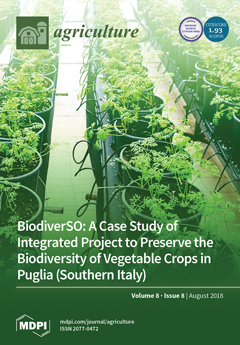Improving the soil quality in arid agro-ecosystems requires a greater understanding of how the time-of-sampling and management affect the soil measurements. We evaluated the selected soil quality indicators on samples collected at a 0–0.15 m depth, and at various sampling dates of the year, corresponding to the fall of 2015, winter of 2015/2016, spring of 2016, and the summer of 2016. The three crop management systems sampled included alfalfa (
Medicago sativa), upland cotton (
Gossypium hirsutum), and pecan (
Carya illinoinensis). The soil properties measured included the wet aggregate stability (WAS), mean weight diameter of dry aggregates (MWD), dry aggregates greater than 2 mm (AGG >2 mm), dry aggregates less than 0.25 mm (AGG <0.25 mm), available water capacity (AWC), soil organic matter (SOM), permanganate oxidizable carbon (POXC), soil bulk density (BD), soil electrical conductivity (EC), pH, nitrate-nitrogen (NO3-N), extractable potassium (K), extractable phosphorus (P), calcium (Ca), magnesium (Mg), sodium adsorption ratio (SAR), and micronutrients (zinc, iron, copper, and manganese). Out of the 21 soil measurements, 15 varied significantly with the time-of-sampling within a year, although there were no consistent trends in variability. However, only a few measurements differed significantly with the crop management practices tested. Wet aggregate stability, MWD, AWC, and BD were significantly higher in the summer, while POXC and SOM were significantly higher in the fall and winter, respectively. Soil quality indicators such as NO3-N, K, and P decreased significantly during the spring. This study shows that the seasonal variability of the soil measurements can be significant in the arid agro-ecosystems, with the magnitude of variation depending on the measurement type. The soil managers in the region need to account for this variability, in order to be able to assess the changes in the soil quality. Also, because of the variability that can occur across the different sampling dates within a year, it is advisable to sample during the same period every year, for a consistent interpretation of the directional changes of the soil quality indicators.
Full article





